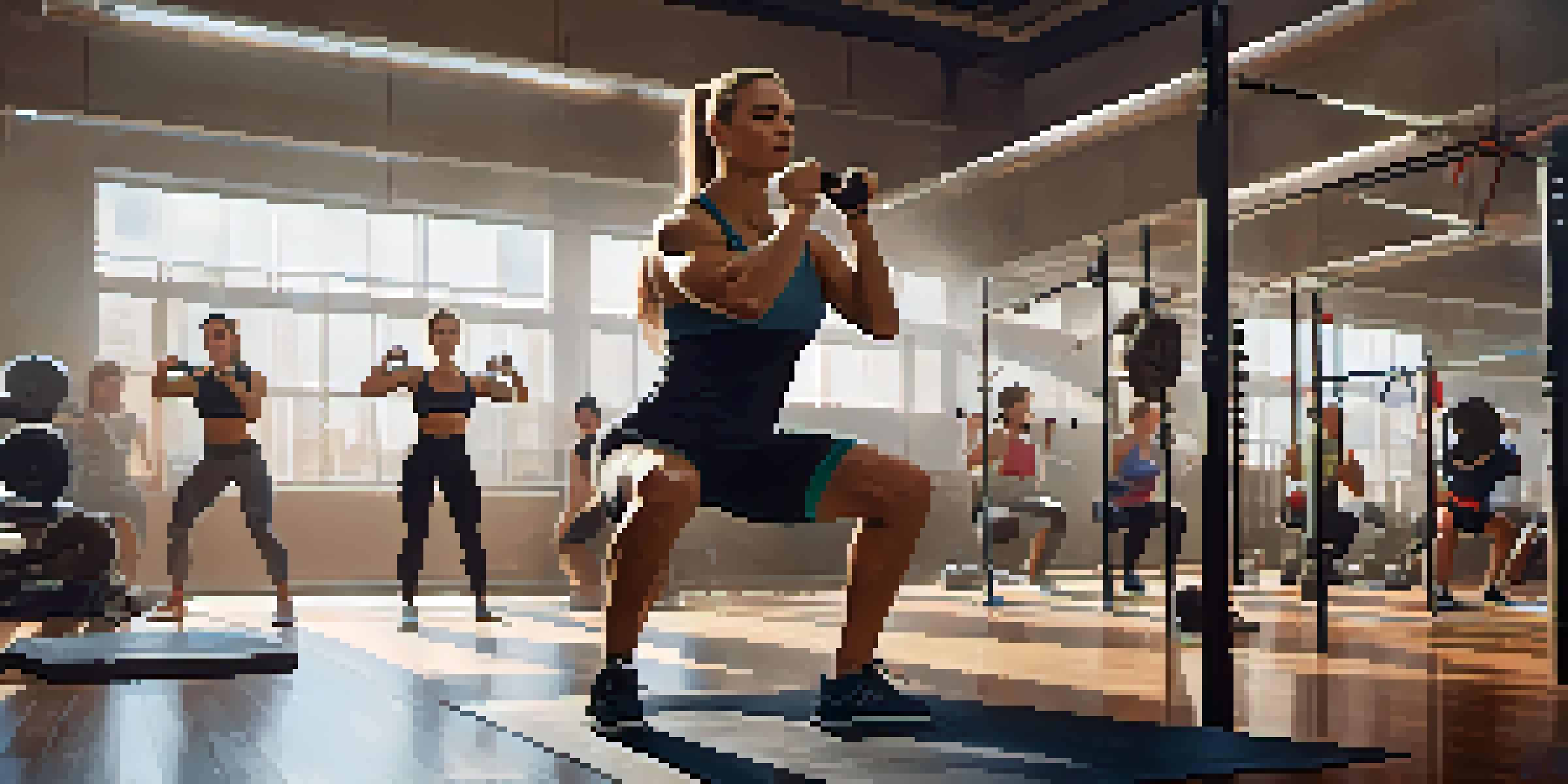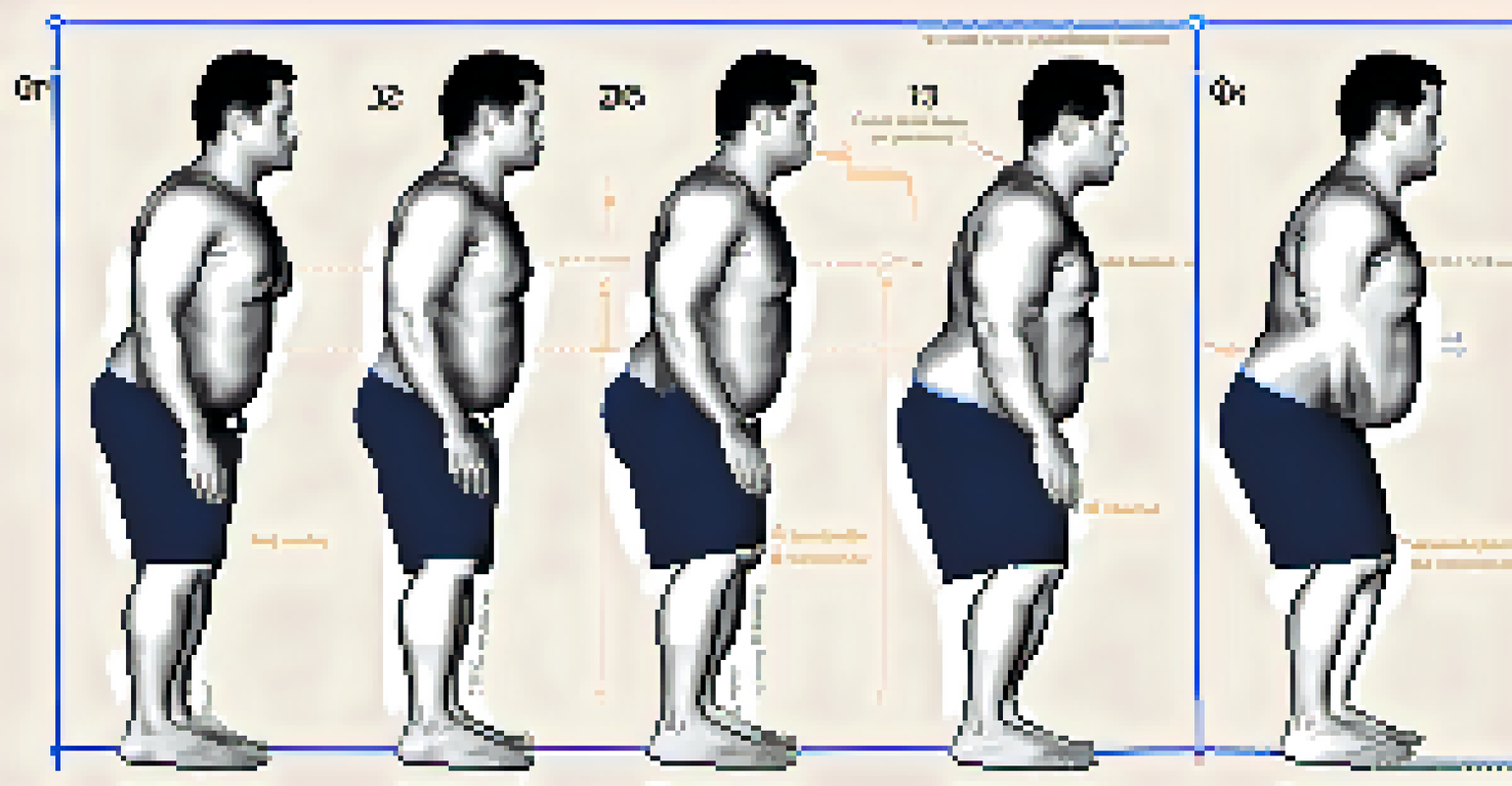Using Squats in Rehab: Powerlifting for Knee Recovery

Understanding the Role of Squats in Knee Rehabilitation
Squats are often seen as a cornerstone of strength training, but they play a crucial role in rehabilitation, especially for knee injuries. When performed correctly, squats can help rebuild muscle strength, improve joint stability, and enhance overall mobility. This makes them particularly beneficial for individuals recovering from knee surgery or injury.
Strength does not come from physical capacity. It comes from an indomitable will.
In rehabilitation settings, squats can be adapted to fit various fitness levels. For instance, someone recovering from a minor knee injury might start with bodyweight squats, while others may incorporate resistance bands to increase difficulty. The key is to listen to your body and progress at a comfortable pace.
Furthermore, squats engage multiple muscle groups, which is essential for comprehensive rehabilitation. By strengthening not just the knees but also the surrounding muscles, patients can achieve better balance and reduce the risk of future injuries.
The Mechanics of a Proper Squat for Rehabilitation
Performing squats with proper form is vital, especially in a rehabilitation context. A well-executed squat involves keeping your feet shoulder-width apart, maintaining a neutral spine, and ensuring that your knees don't extend past your toes. This alignment helps prevent undue stress on the knee joints.

In rehab, the focus should be on slow, controlled movements rather than speed or heavy weights. The goal is to build strength and endurance without aggravating the injury. Start with a limited range of motion and gradually increase it as your strength and confidence improve.
Squats Aid Knee Rehabilitation
Performing squats correctly can help rebuild muscle strength, improve joint stability, and enhance overall mobility for those recovering from knee injuries.
Incorporating tools like a box or bench can also help those in rehab. By squatting to a set height, individuals can focus on form and ensure they aren't pushing their limits too soon.
Benefits of Squats in Powerlifting for Recovery
Powerlifting emphasizes strength training, making it an excellent framework for rehab exercises like squats. The progressive overload principle, which involves gradually increasing weights, can help rehabilitate the knee while ensuring that muscles adapt safely over time. This method fosters both strength and confidence in the injured area.
The greatest glory in living lies not in never falling, but in rising every time we fall.
One significant benefit of using powerlifting techniques in rehab is the focus on low repetitions with higher weights. This approach can efficiently build strength without overworking the knee joint, which is crucial during recovery.
Moreover, powerlifting encourages a strong mind-muscle connection. By concentrating on each squat, individuals can become more aware of their body's movements, leading to better form and reduced risk of re-injury.
Integrating Squats with Other Rehabilitation Exercises
While squats are beneficial, they should be part of a broader rehabilitation program. Integrating other exercises such as leg presses, lunges, and hamstring curls can provide a balanced approach to knee recovery. This variety helps target different muscle groups and prevents overuse injuries.
Additionally, incorporating flexibility and mobility work, like yoga or stretching, can enhance the effects of squats in rehab. Improving overall flexibility around the knee joint can lead to better performance during squats and other exercises.
Proper Form is Essential
Maintaining proper form during squats is vital to prevent undue stress on the knees and ensure effective rehabilitation.
A well-rounded routine keeps rehabilitation engaging and reduces the chance of plateauing. It's essential to work with a physical therapist or trainer to develop a personalized program that includes squats and other complementary exercises.
The Importance of Warm-Up and Cool-Down
Before diving into squats, a proper warm-up is crucial to prepare the muscles and joints for the workout ahead. Dynamic stretches and light cardio can increase blood flow and reduce the risk of injury. A warm-up specifically targeting the lower body can enhance the effectiveness of squats during rehab.
Similarly, cooling down after a workout is just as important. Incorporating static stretches and foam rolling can help alleviate muscle tightness and promote recovery. This practice contributes to overall muscle health and flexibility, which is vital for anyone recovering from a knee injury.
Remember, taking the time to warm up and cool down can significantly impact your recovery journey. It sets the tone for your workout and enhances the benefits of each squat repetition.
Listening to Your Body: Signs to Watch For
As you incorporate squats into your rehabilitation, it's essential to listen to your body. Pay attention to any pain or discomfort during or after the exercise. While some soreness is normal, sharp pain may indicate that you're overdoing it or using incorrect form.
Monitoring your body's response can help you adjust your routine as needed. If you experience pain, consider reducing the weight or range of motion, or even taking a break altogether. Your recovery should be gradual, and it's essential to prioritize your long-term health over short-term gains.
Integrate with Other Exercises
Integrating squats with a variety of other rehabilitation exercises can provide a balanced approach to knee recovery, reducing the risk of overuse injuries.
Consulting with a healthcare professional can also provide valuable feedback. They can help you determine whether your squat technique needs adjustment or if it's time to modify your rehabilitation plan.
Final Thoughts on Squats in Knee Recovery
Incorporating squats into your rehabilitation program can be a game-changer for knee recovery. Not only do they help build strength, but they also improve overall mobility and stability. When approached mindfully, squats can empower individuals to regain confidence in their movement.
Remember, the journey to recovery is unique for everyone. It's important to be patient and allow your body the time it needs to heal. Celebrate the small victories along the way, as they contribute to your overall progress.

Ultimately, the goal of rehabilitation is to return to a pain-free, active lifestyle. With squats as part of your routine, you're setting yourself up for success on that journey.